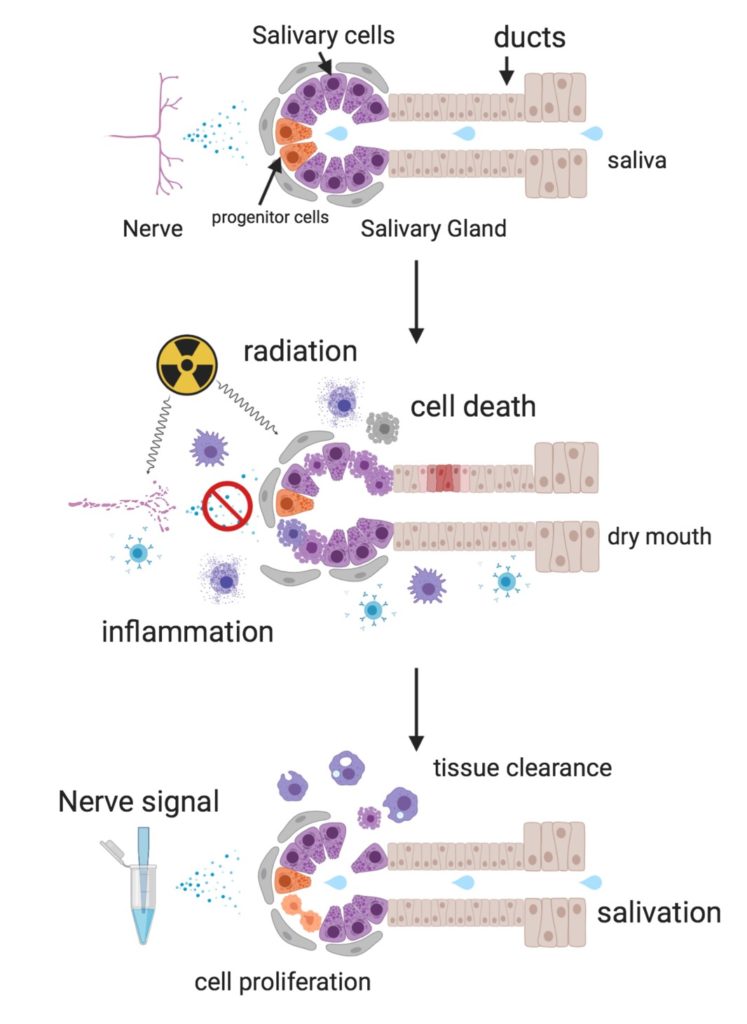Regeneration takes some nerve

On Thursday the 26th of September Dr. Elaine Emmerson from the Scottish Centre for Regenerative Medicine gave an excellent talk on the manipulation of the parasympathetic nerves of the salivary gland and how this could be used in a therapeutic setting.
The dysfunction of the salivary glands causes a range of symptoms, including difficulty swallowing food, impairment of speech and rapid tooth decay (Emmerson & Knox, 2018). Damage often occurs to the salivary glands following radiotherapy to treat cancers in the head and neck leaving patients with a long-lasting debilitating condition which has no cure. Thus, there is a significant unmet need to develop a long-lasting and effective treatment for this disorder.
Salivary glands consist primarily of ducts, acini (the cells which secrete the saliva) and the parasympathetic nervous system. It has long been known that there is an interaction between the nervous system and the salivary glands. Dr. Emmerson elegantly demonstrated this using a Phox2b K/O mouse to ablate the parasympathetic nerves in the salivary gland. This led to a smaller and underdeveloped salivary gland. Notably the ablation of the parasympathetic nerves caused a decrease in the number of Sox2+ cells in the salivary gland (Emmerson et al, 2017).
Following extensive work using a Cre inducible Sox2 K/O mouse along with lineage tracing experiments it became clear that a subset of AQP5+ (a marker of the acini lineage) Sox2+ cells are responsible for the regeneration of the acini cells but not the duct cells during normal homeostasis. These findings demonstrated that the parasympathetic nervous system acts on Sox2+ cells to promote acini development and regeneration. This could be replicated using acetylcholine mimetics in salivary gland cultures which lacked the parasympathetic nerves (Emmerson et al, 2018). During radiotherapy both the acini of the salivary glands and the parasympathetic nerves are damaged and destroyed. These results suggest that it is the destruction of the parasympathetic nerves that causes the loss of regeneration in salivary glands and gives hope that a curative treatment may be possible.
Dr. Emmerson hopes to achieve exactly this by targeting the Sox2+ cells of patients with cholinergic signalling molecules to mimic the action of the parasympathetic nervous system and stimulate regeneration of the salivary gland. Using high throughput imaging software and a fluorescent reporter model which allows easy identification of Sox2+ cells she hopes that screening drugs from repurposing databases will find a pre-tested drug that could be delivered to patients using a highly specific in-vivo delivery system. Alternatively, it may be possible to separate out a pure population of Sox2+ stem cells using novel cell surface markers and perfect an implantation technique to rescue acini regeneration.
Not only has Dr. Emmerson demonstrated a relationship between the parasympathetic nervous system and the acini progenitor cells of the salivary glands, this seminar was a prime example of how fundamental research and mouse genetics can inform on the development and treatment of human disease.
References and further reading:
Emmerson, E., & Knox, S. M. (2018). Salivary gland stem cells: A review of development, regeneration and cancer. Genesis, 56(5), e23211.
Emmerson, E., May, A. J., Nathan, S., Cruz-Pacheco, N., Lizama, C. O., Maliskova, L., … Knox, S. M. (2017). SOX2 regulates acinar cell development in the salivary gland. ELife, 6.
Emmerson, E., May, A. J., Berthoin, L., Cruz-Pacheco, N., Nathan, S., Mattingly, A. J., … Knox, S. M. (2018). Salivary glands regenerate after radiation injury through SOX2-mediated secretory cell replacement. EMBO Molecular Medicine, 10(3).

John McKendrick, created with BioRender.



